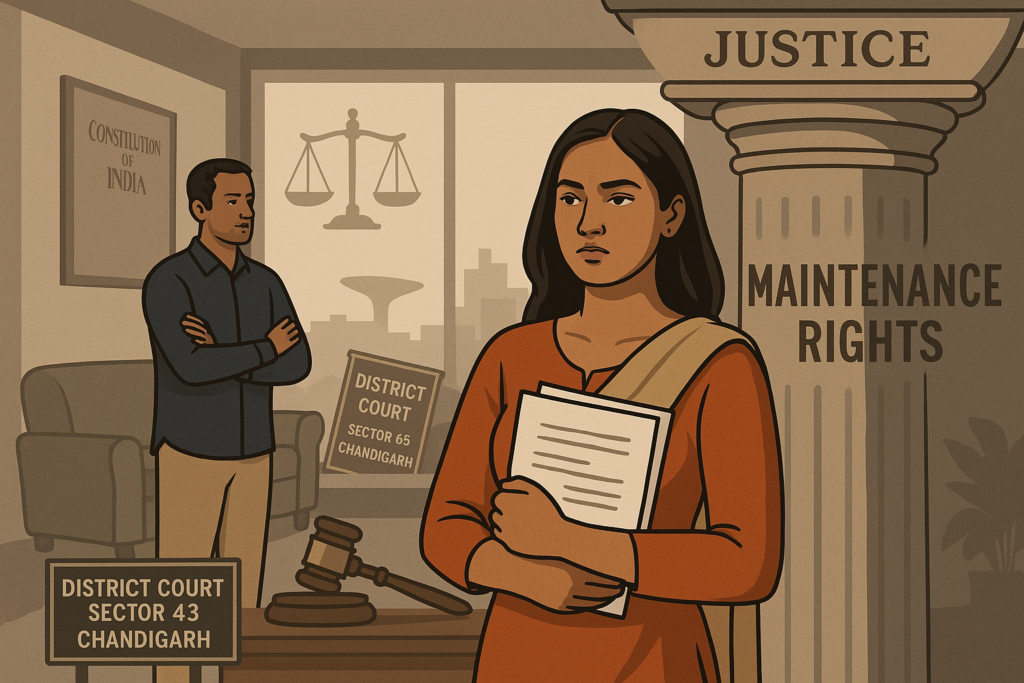The question of whether live-in partners can claim maintenance in India has increasingly become significant as societal norms evolve and non-marital relationships gain recognition. With changing social structures and legal interpretations, the Indian judiciary has slowly begun recognizing the rights of partners in live-in relationships, particularly concerning maintenance and financial support.
In this article, we delve into the legal framework governing maintenance claims by live-in partners in India, discuss important Acts, Sections, and case law, and outline the current legal position. This guide is intended for both law students and clients seeking legal clarity on this topic, especially those exploring legal remedies through lawyers in Chandigarh or high court advocates in Chandigarh.
Understanding the Concept of Live-in Relationships in India
Definition and Social Context
A live-in relationship refers to a domestic arrangement where two people cohabit without entering into a formal marriage. While such arrangements are socially debated, the law in India does not prohibit live-in relationships between consenting adults.
Judicial Recognition
Indian courts have acknowledged live-in relationships, especially when they resemble the characteristics of a marriage. The Supreme Court of India has held in multiple cases that if a couple lives together for a significant period, they may be presumed to be legally married for certain civil benefits, including maintenance.
Legal Provisions Related to Maintenance in Live-in Relationships
Several statutes and judicial interpretations form the basis of maintenance claims by live-in partners. However, there is no standalone law specifically dealing with live-in relationships. The courts often interpret existing laws to address such claims.
Protection of Women from Domestic Violence Act, 2005 (PWDVA)
Section 2(f) of the PWDVA defines a “domestic relationship” as a relationship between two persons who live, or have lived together in a shared household, when they are related by:
- Consanguinity
- Marriage
- Relationship in the nature of marriage
This definition includes live-in relationships that resemble marriage.
Section 12 – Right to Reliefs
Under Section 12, an aggrieved woman can seek multiple reliefs including:
- Protection from abuse
- Residence orders
- Monetary reliefs (including maintenance)
Interpretation by Courts
The courts have interpreted the phrase “relationship in the nature of marriage” to mean a stable, long-term relationship akin to marriage, excluding casual or secret relationships.
Bharatiya Nagarik Suraksha Sanhita, 2023 (BNSS)
Traditionally, Section 144 BNSS provides maintenance to a:
- Wife
- Legitimate or illegitimate minor child
- Father or mother
However, courts have extended this provision to include female live-in partners, provided they meet certain legal criteria.
Supreme Court Precedents
In Chanmuniya v. Virendra Kumar Singh Kushwaha (2011), the Supreme Court held that:
A woman who is party to a live-in relationship is entitled to maintenance if the relationship is of the nature of marriage.
The Court further observed that denying maintenance would amount to violating the spirit of Article 21 of the Constitution, which ensures the right to live with dignity.
Conditions to Claim Maintenance in a Live-in Relationship
To claim maintenance, the female live-in partner must meet specific conditions:
Duration and Stability of Relationship
The courts consider the duration, stability, and public recognition of the relationship. Short-term, casual, or secret relationships do not qualify.
Shared Household
The couple must have lived together in a shared household. This is crucial for relief under the Domestic Violence Act.
Exclusivity and Legality
- The relationship must be monogamous
- Both partners must be legally eligible to marry
If either party is already married to someone else, the relationship may not qualify for maintenance.
Legal Rights of Live-in Partners in India
Right to Maintenance
Recognized under Section 144 BNSS and PWDVA, if the relationship qualifies as “in the nature of marriage”.
Right to Residence
Under Section 17 of the PWDVA, a woman has the right to reside in the shared household, even if she has no title or ownership.
Right to Protection
Live-in partners are also entitled to protection from domestic violence, harassment, and abuse under the PWDVA.
Legal Challenges and Grey Areas
No Codified Law
There is no specific statute dealing with live-in relationships or their consequences, creating reliance on judicial interpretations.
Burden of Proof
The burden to prove the existence of a “relationship in the nature of marriage” lies heavily on the claimant. Documentary evidence, social acknowledgment, and duration of cohabitation are key.
Regional Variations
Implementation and judicial approaches can vary across jurisdictions. High court lawyers in Chandigarh are often required to navigate nuanced case law depending on whether the case is being heard in Punjab, Haryana, or Chandigarh UT.
Landmark Judgments
D. Velusamy v. D. Patchaiammal (2010)
The Supreme Court laid down conditions for recognizing a live-in relationship:
- The couple must behave like spouses
- The relationship must be long-standing
- The woman must not be legally married to someone else
Indra Sarma v. V.K.V. Sarma (2013)
The Court listed factors like duration, social context, financial arrangement, and sexual relationship to determine whether a live-in relationship qualifies for maintenance.
Can Male Partners Claim Maintenance?
No Provision for Males
Under current Indian law, only women in live-in relationships can claim maintenance. Male partners have no legal provision under PWDVA or BNSS to seek financial support from female partners.
Jurisdiction to File Maintenance Claims in Chandigarh
Maintenance claims by live-in partners in Chandigarh can be filed at:
- District and Sessions Court, Sector 43, Chandigarh under PWDVA or BNSS
- Punjab and Haryana High Court, especially in case of writ petitions or appeals
For strategic legal filing, it is advisable to work with advocates in Chandigarh or high court lawyers in Chandigarh well-versed in family law.
Practical Steps to Claim Maintenance in Chandigarh
Step 1: Legal Consultation
Meet with experienced lawyers in Chandigarh to assess the eligibility of your relationship.
Step 2: Documentation
Gather evidence like:
- Joint residence proof
- Photos, joint bank accounts, or lease agreements
- Witness statements
Step 3: Drafting the Application
The application should include:
- Nature and duration of the relationship
- Monthly expenses and financial needs
- Proof of shared household and cohabitation
Step 4: Filing the Petition
File the petition under Section 12 of PWDVA or Section 144 BNSS in the appropriate family or magistrate court in Chandigarh.
Step 5: Court Proceedings
The respondent will be served notice. The court will assess:
- Existence of a live-in relationship
- Financial capacity of the partner
- Reasonable requirement of the claimant
Maintenance for Children from Live-in Relationships
Children born out of live-in relationships are legitimate as per Supreme Court judgments. They are entitled to:
- Maintenance under Section 144 BNSS
- Inheritance rights under personal laws
This area often involves high court advocates in Chandigarh, especially in disputes over legitimacy or property.
Live-in partners in India, particularly women, are increasingly being granted maintenance rights under existing legal frameworks, especially when the relationship closely mirrors a marital arrangement. Courts have played a proactive role in ensuring financial security and dignity, aligning with Article 21 of the Constitution.
While there’s no dedicated statute governing such relationships, remedies under the PWDVA and BNSS offer substantial legal protection. If you’re facing a similar issue, whether as a claimant or respondent, it’s essential to navigate the legal process with guidance from experienced divorce lawyers in Chandigarh or high court advocates in Chandigarh familiar with local judicial trends and documentation requirements.
FAQs Can Live-in Partners Claim Maintenance in India?
1. Can a woman in a live-in relationship claim maintenance in Chandigarh?
Yes, a woman in a live-in relationship can claim maintenance in Chandigarh if the relationship is “in the nature of marriage.” She may file for maintenance under Section 144 of the Bharatiya Nagarik Suraksha Sanhita (BNSS) or the Protection of Women from Domestic Violence Act (PWDVA). It is advisable to seek assistance from experienced advocates in Chandigarh or lawyers in Chandigarh who are well-versed in family and criminal law matters.
2. How do I prove a live-in relationship legally?
To prove a live-in relationship, courts in Chandigarh typically require evidence of long-term cohabitation, a shared household, and public acknowledgment of the relationship. This can include joint financial records, photographs, rental agreements, and witness statements. Working with knowledgeable divorce lawyers in Chandigarh or high court advocates in Chandigarh can help present such evidence effectively.
3. Can a man file for maintenance in a live-in relationship?
No, under the current legal framework, including the PWDVA and Section 144 of BNSS, only women are entitled to claim maintenance. Male partners in live-in relationships do not have statutory rights to maintenance but may explore civil remedies with guidance from high court lawyers in Chandigarh or advocates in Chandigarh who specialize in matrimonial and constitutional matters.
4. Where should I file the maintenance case in Chandigarh?
Maintenance petitions related to live-in relationships should be filed at the District & Sessions Court in Sector 43, Chandigarh, under the PWDVA or BNSS Section 144. For appeals, writ petitions, or complex jurisdictional matters, the case can be taken to the Punjab and Haryana High Court through experienced high court lawyers in Chandigarh or high court advocates in Chandigarh.
5. Are children from live-in relationships eligible for maintenance?
Yes, children born from live-in relationships are considered legitimate by Indian courts and have full rights to maintenance and inheritance. This legal status has been upheld by the Supreme Court of India and various High Courts, including the Punjab and Haryana High Court. For child maintenance petitions, it is best to work with seasoned lawyers in Chandigarh who specialize in family law.

